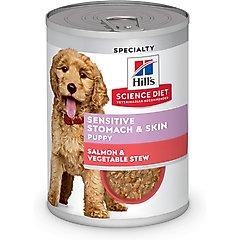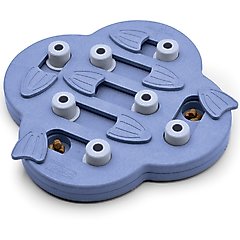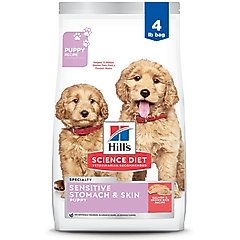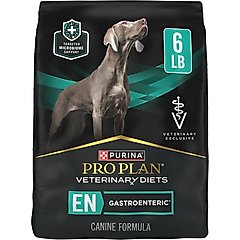Why Is My Puppy Vomiting? What Should I Do?

Photo by Sviatlana Barchan/iStock/Getty Images Plus
One moment your puppy is happily zooming around, and the next they’re throwing up on your favorite rug (because somehow it’s always on the rug).
Sometimes puppy puking is just a case of your pooch snarfing their food or experiencing a minor tummy upset, but other times it’s a sign that something more serious is going on.
We spoke to two veterinarians to understand the ins and outs (pun intended) of puppy vomiting, including its possible causes, when to call a vet, and how to help your pup feel better.
Why Is My Puppy Throwing Up? 9 Possible Causes
“Vomiting is generally always abnormal and is a vague sign that can be due to many causes, some of which are more serious than others,” says Samantha Kent, DVM, medical director of VEG ER for Pets in Encinitas, California.
The most common reasons for puppy vomiting include:
- Eating too fast: When puppies gobble down their food too quickly, it can lead to regurgitation (throwing up undigested food soon after eating).
- Dietary indiscretion: Puppies are naturally curious and might eat non-food items, such as poop or garbage, which can upset their stomach, says Joshua Smith, DVM, owner of Pawspital Animal Hospital, in Meridian, Idaho.
- Food sensitivities or diet changes: Switching your puppy’s food too quickly or feeding something that doesn’t agree with their stomach (treats, people food) can lead to digestive upset.
- Intestinal parasites: Roundworms, hookworms, and other parasites are common in puppies and can cause vomiting, diarrhea, and other gastrointestinal issues.
- Infections or illness: “Puppies are still building their immune system and are more vulnerable to viruses or bacteria that can cause nausea and vomiting,” Dr. Smith says. The most serious cause of vomiting in puppies is parvovirus.
- Foreign object ingestion: If your puppy swallows a toy, sock, or other non-food object, it can cause a bowel obstruction, leading to vomiting.
- Motion sickness: “Some puppies get carsick just like some people do,” Dr. Smith says. “The motion from a ride can make them feel nauseous, leading to vomiting.”
- Toxins or poisoning: Ingesting toxic plants, household cleaners, an overdose of supplements or ingestion of medications (veterinary or human, over the counter or prescription), or human foods that are toxic to dogs, such as chocolate, can lead to vomiting.
- Underlying health conditions: Rarely, certain congenital issues (birth defects) such as liver disease or kidney problems can lead to vomiting in puppies.
Puppy Vomit Color Chart
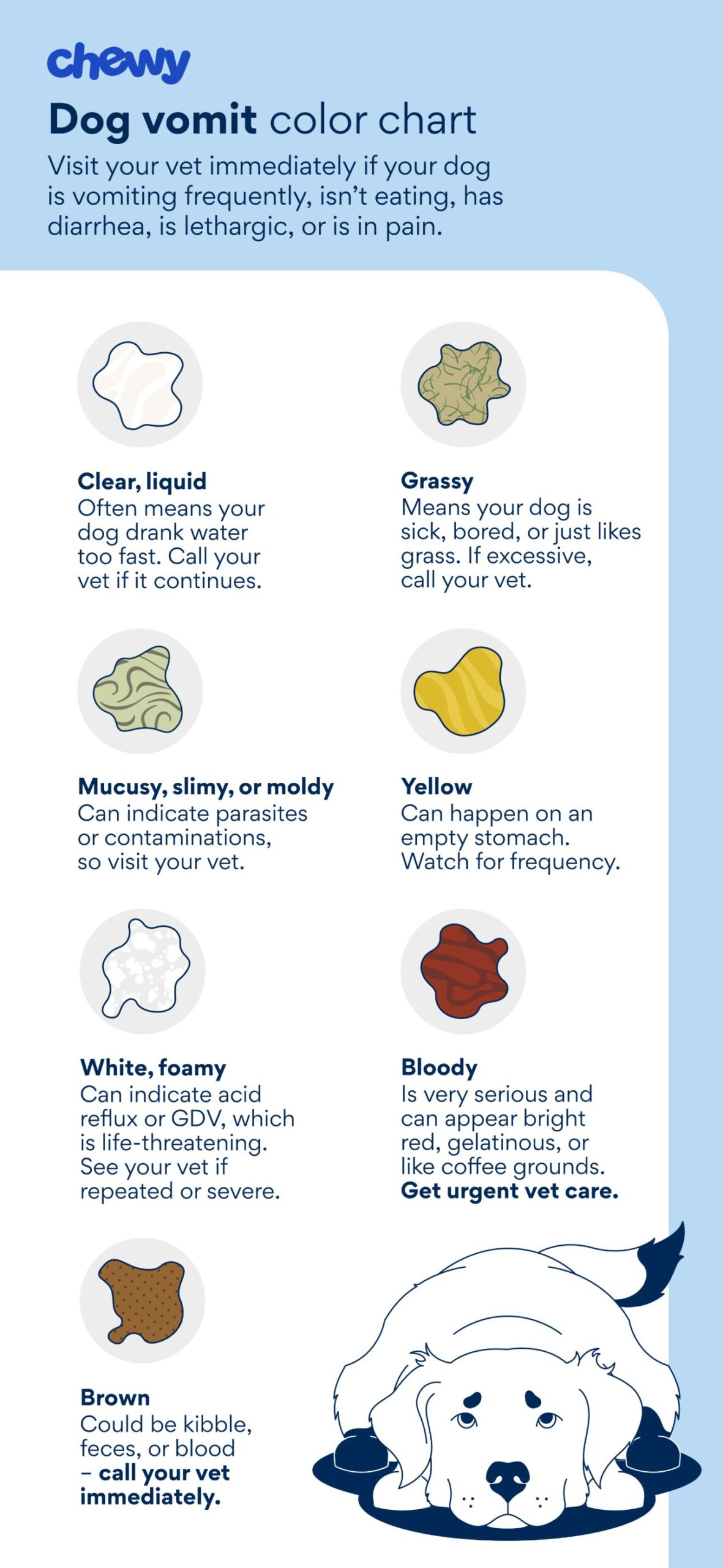
Photo by Chewy
The color of your puppy’s vomit can offer important clues about their health. Here’s what different vomit colors might mean and how to respond, according to our veterinary experts.
Yellow
- What it might mean: Bile from an empty stomach; might be caused by going too long between meals
- What to do: Feed smaller, more frequent meals and give a snack before bedtime; call a vet if persistent
White and Foamy
- What it might mean: Empty stomach, acid buildup; might be caused by stomach irritation, obstruction, or kennel cough
- What to do: Monitor for other symptoms; if it happens regularly or more than one or two times in a 24-hour period, call a vet
Chunky Food Pieces
- What it might mean: Undigested food; might be due to eating too fast
- What to do: Try a slow feeder bowl; no treatment necessary for an isolated occurrence; if it happens regularly or more than one or two times in a 24-hour period, call a vet
Green
- What it might mean: Bile, grass ingestion
- What to do: Reduce dog’s access to grass; call a vet if vomiting continues
Red or Streaks of Red
- What it might mean: Fresh blood from stomach ulceration; ate something with red food coloring
- What to do: If your dog hasn’t eaten food with red dye, call a vet immediately
Black
- What it might mean: Digested blood (which looks like coffee grounds), possible GI bleed; dog ate dirt
- What to do: Call a vet immediately
Clear Liquid
- What it might mean: Empty stomach; stomach irritation, obstruction, or drinking water too fast
- What to do: Pace water intake and monitor; if it happens more than one or two times in a 24-hour period, call a vet
Brown or Smells Like Poop
- What it might mean: Dog food or poop ingestion
- What to do: If it happens more than one or two times in a 24-hour period, call a vet; if your dog is eating poop, talk to your vet about how to stop this behavior
Foreign Object
- What it might mean: Non-food item ingestion (e.g., fabric, piece of a toy, etc.)
- What to do: If your dog has no further vomiting or other signs of obstruction, monitor them; if they’re vomiting but not producing any stool, call a vet immediately or take them to a pet emergency clinic
How Can I Help My Sick Puppy at Home?
If your puppy vomits once and seems fine afterward, you probably don’t need to take immediate action.
If they’ve vomited a couple of times, call your vet, as vomiting can leave puppies feeling unwell and at risk for dehydration, says Dr. Kent. “This is especially true if the puppy is younger and smaller or if they’re also not eating.”
Depending on the situation, your vet might recommend an in-person evaluation or suggest a watch-and-see approach at home. If monitoring at home is appropriate, your vet might recommend one or more of the following:
- Withhold food temporarily. A young puppy, especially a small breed or toy breed, is at risk for hypoglycemia, so vets will often fast them for a shorter period of time—generally around two to three hours. How long a puppy should fast from food and water is highly dependent on their age, size, possible underlying causes, and the presence of other symptoms. Speak to your vet.
- Feed a bland diet. Once they seem ready to eat, you can offer small, frequent meals of a bland diet, such as plain, boiled chicken (skinless and boneless) with white rice, prepared without seasoning, oil, or butter, Dr. Smith says. “This is gentle on their stomach and can help them ease back into normal eating.” Even better, consider a highly digestible premade puppy food, such as Hill’s Science Diet Sensitive Stomach & Skin Puppy.
- Slow down fast eaters. If your puppy eats too quickly, try feeding them using a slow feeder bowl, such as the Frisco Bone Shaped Ridges Slow Feed Bowl or using a puzzle feeder, such as Nina Ottosson by Outward Hound Dog Hide N Slide Dog Toy.
- Limit activity. Rest is important for recovery. Keep your puppy calm and avoid vigorous play until they’re feeling better.
- Make them comfortable. Provide your puppy with a cozy bed to rest in, like the Frisco Faux Suede Bolster Dog Bed.
Recommended Products
When Should I Take My Puppy to the Vet?
Immediately contact your vet or an emergency pet clinic if your puppy experiences any of the following:
- Vomiting more than once
- Vomiting accompanied by diarrhea (known as gastroenteritis)
- Vomiting blood (bright red or resembling coffee grounds)
- Vomiting foreign material
- Vomiting along with lethargy, decreased appetite, or other unusual behaviors
- Persistent, non-productive retching that doesn’t bring up vomit
Treatment for puppy vomiting depends on the root cause, and your veterinarian will recommend the most appropriate course of action. Possible treatments might include:
- Short-term fasting: A brief, vet-supervised fast to give the digestive system time to recover
- Bland or hypoallergenic diet: Feeding easily digestible diets like:
- Science Diet Puppy Sensitive Stomach Dry Dog Food
- Homemade foods such as boiled chicken and rice
- Vet-authorized formula, such as Purina Pro Plan Veterinary Diets EN Gastroenteric (for digestion issues)
- Anti-nausea medication: Prescription medication to control nausea and motion sickness, such as Cerenia
- Probiotics: Such as Purina Pro Plan Veterinary Diets FortiFlora Chewable Tablets to support healthy gut bacteria and aid digestion
- Surgery: In cases of foreign object ingestion or severe gastrointestinal damage, surgery might be necessary.
- Targeted treatments: If the vomiting stems from an issue outside the digestive tract, such as liver or kidney disease, your vet will recommend treatments specific to that condition.
Recommended Products
FAQs About Puppy Vomiting
Q: Why is my puppy vomiting white foam?
A: White foam usually indicates an empty stomach, acid buildup, or mild stomach irritation. It can also be a sign of kennel cough or other respiratory issues. If it happens more than once or alongside other symptoms, call your vet.
Q: Why is my puppy vomiting yellow mucus?
A: Yellow mucus often means your puppy is vomiting bile, usually from an empty stomach. This can happen if they go too long between meals. Feeding smaller, more frequent meals and giving a snack before bedtime can help. If vomiting continues, call your vet.
Q: Why is my puppy throwing up their food? Can overfeeding cause vomiting in puppies?
A: Yes, overfeeding can lead to vomiting, especially if a puppy eats too quickly. Other causes include food sensitivities, obstruction, gastrointestinal upset, or underlying health issues. Try smaller portions and a slow feeder bowl or puzzle feeder. If vomiting continues, call your vet.
Q: What should I do if my puppy is vomiting and has diarrhea?
A: Vomiting and diarrhea together can quickly lead to dehydration, especially in young puppies. In this case, call your vet or an emergency pet clinic for guidance.
Attributions
This content was medically reviewed by Molly Price, DVM, Chewy veterinarian.
